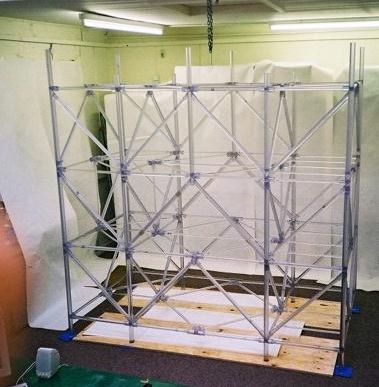
NEWSLETTER
Using Sound to Find Cracks
Or
Cost-Effective Structural Monitoring For Existing Offshore Structures

|
NEWSLETTERUsing Sound to Find Cracks |
A Cambridge-based research Company is investigating how sound waves can be used to spot the appearance of cracks or other damage in a jacket structure. The HSE is supporting Mecon Limited in a feasibility study being carried out on a model-scale structure.
The principle of the method is simple. A set of small piezoelectric ceramic devices located near the top is used to "ping" the structure, injecting sharp, high-intensity sound pulses into the main legs. These travel through the structure, and are eventually picked up by a set of piezoelectric receivers. The pattern of the sound they pick up depends on the details of the structure, and if something changes, the change will be reflected in the sound pattern. The timing and magnitude of the changes gives us information on where in the structure the change has occurred, and how big it is.
The method will be useful if it can fill a gap in the range of methods currently available for monitoring structural health. Potentially, the new acoustic method will fit neatly between the modal analysis method, which monitors the sway frequency of a jacket structure under wave loading, and ultrasonic inspection. The modal method uses frequencies well below the frequency range of sound. Its sensitivity to changes other than damage to major structural members is very limited: even gross damage to structurally redundant members may not affect it detectably, because it measures the stiffness of the entire structure. It is however relatively simple to use. At the other end of the frequency scale, ultrasonic inspection can detect cracks in any joint or member from a very early stage, but can only cover small areas of the structure at a time. It usually requires divers and is expensive and time-consuming. The acoustic method will fit in the middle: while not as sensitive as ultrasound, it is likely to be significantly more sensitive than the modal method. It is well suited to automation, and could monitor structural health continuously.
So how sensitive is the acoustic method, and how well can it locate any damage that it detects? These are questions that Mecon is currently working on, using experiments on a tenth-scale rig made of polycarbonate.
The rig in the picture is a model of the upper part of an in-service North Sea jacket structure. There are eight sound-injection, and eight sensing points. At the moment the sound is injected at the tops of the main legs and detected at the bottoms; this is akin to the imaging method known as "transmission tomography", used in medical imaging and downhole seismology, in which energy is shone through an object (be it a human body or a hydrocarbon reservoir) in various directions in order to build up a picture of its internal structure. Computer modelling suggests however that the acoustic method will work at least as well with both actuators and sensors at the top of the legs, which would make it much easier to implement in practice. This is much more like the reflection technique commonly used in exploration seismology, prenatal foetal scanning and ultrasonic NDT.
The new acoustic method has been tried out both on data recorded on the scale model rig, and using data created using a computer model of the rig. The computer simulations show that the method is well able to pinpoint the location of the source of changes in the acoustic signals, and can identify a damaged joint anywhere in the structure. The experiments on the rig show that, as expected, the method will begin to register a crack once it has grown large enough to affect the physical stiffness of the joint. Likewise, any damage which either removes material from the structure or affects its stiffness (such as a loose clamp or a large dent) will show up.

Research on the method continues. The effectiveness of the "reflection" method (with both transmitters and receivers at the top of the structure, above the waterline) needs to be demonstrated by experiment; and it must be shown that the method can be prevented from mistaking topsides changes (such as the shifting of heavy machinery) for changes to the jacket structure. In principle this is straightforward: directional receivers can distinguish whether a signal arrives from above or below. But it needs to be shown that this will work in practice. Once these issues are settled, the next step must be to demonstrate the method on a steel structure in water.
So far, then, results are promising. The method looks likely to live up to its potential to fill the gap between the simple but relatively insensitive modal method and extremely sensitive but expensive ultrasonic inspection. It uses a limited number of transducers to detect cracks, physical damage or other changes to the jacket's structural properties. The aim is to produce a permanently-installed system that monitors the structure continuously, requiring operator intervention only when a structural change is detected.